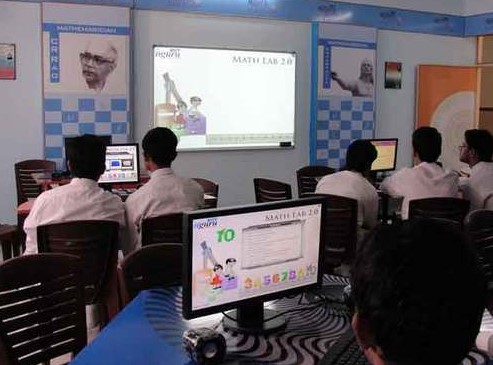The role of audio-visual (AV) technology has become increasingly popular in education. Both students and teachers have more immersive experiences that change the way they learn and deliver new content.
From interactive displays and multimedia presentations to remote learning and virtual stimulation, AV technology offers a wealth of tools that make teaching enjoyable and memorable for everyone.
So, how is audio-visual content shaping education? Discover the exciting possibilities and benefits of this immersive technology in shaping the future of education. Just keep reading to find out more. 
Five Ways AV technology plays a role in Education
With technology constantly evolving, it’s no surprise that the education sector is using this emergence to foster better learning techniques. Students and teachers can immerse themselves in complex topics without getting bored or losing interest in traditional teaching methods.
Explore the five ways AV technology impacts education below.
1. Enhances engagement and learning experiences
Incorporating AV technology into education can increase student engagement. This is because traditional methods, such as explaining information verbally, often struggle to hold students’ attention for a long period. Therefore, introducing fun and dynamic elements to the classroom, either through multimedia presentations or interactive displays, can enhance concentration.
The use of multimedia presentations makes concepts more fun and understandable. Students don’t need to rely on text-based materials alone, meaning teachers can explain concepts using videos and animations. Video display controllers are the best gadget for presenting engaging content on a multi-screen display.
A video display controller can also combine live video feeds with presentation slides. Students can see a range of digital content in front of them, which allows side-by-side comparisons or content overlays. These interactive resources will keep students engaged and interested in challenging subjects.
2. Offers personalized and adaptive learning
Every student has their own strengths, weaknesses, and learning styles. AV technology encourages teachers to tailor learning techniques to these individual needs, giving students targeted support and opportunities for growth.
Many AI-driven tools and educational software play a crucial role in personalized education. For example, intelligent tutoring systems (ITS) like Carnegie Learning or DreamBox use AI algorithms to deliver feedback based on the student’s learning needs and individual performance. Virtual learning assistants can also engage in interactive conversations to offer tailored guidance.
In terms of adaptive learning, platforms such as Knewton or Smart Sparrow use AI to analyze students’ data and create educational content according to their learning styles and needs.
3. Enriches content delivery
AV technology offers diverse and engaging ways to present information to students. This option can be more effective than basic textbook knowledge or lectures that involve non-stop verbal communication.
One way audio-visual content enhances learning is through virtual reality (VR) and augmented reality (AR). These technologies introduce students to computer-generated environments containing historical settings or medical stimulations. By bringing content to life, students can explore three-dimensional models of complex topics to foster active participation.
Moreover, live streaming and video conferencing tools allow remote guest speakers and subject matter experts to speak in the classroom without being there. This AV technology enhances the learning experience because students can ask questions and engage in interactive discussions to build a connected, educational community.
4. Fosters collaboration and communication
Collaborative tools and platforms encourage students to connect, interact, and collaborate with their peers. Some examples include online discussion forums and shared document editors for enabling seamless communication. This fosters a sense of community because students can engage in teamwork.
Live streaming technologies facilitate real-time communication between students and teachers in different locations. Those who have to learn at home for personal reasons can still engage with their classmates through video conferencing technology, promoting a globalized and interconnected world.
Inclusive collaboration is also essential for every teacher and student. AV technology accommodates diverse learning needs, whether that’s sign language interpretation or closed captions, to engage students with disabilities or language barriers. These practices build a collaborative and supportive environment.
5. Provides professional development and teacher training
AV technology encourages professional development for teachers. Online learning platforms and webinars give educators a range of courses, workshops, and training resources related to technology integration and classroom management. This is especially useful for educational departments that want to use multimedia presentations and collaborative activities to enhance the learning process.
Teachers can also participate in professional learning communities from anywhere in the world, bringing experts and leaders together. Through live streaming and interactive Q&A sessions, these professionals will learn new teaching techniques that foster a culture of continuous learning and growth.
Entry-level teachers may use video-based coaching and mentoring to receive feedback from instructional coaches. This approach enables self-assessment and reflection, even during their spare time.
The Future of AV Technology in education
AV technology holds exciting prospects for transforming learning in the education sector. One example includes the rise of artificial intelligence (AI) and machine learning to provide intelligent tutoring systems. This tailored content delivery will help students to feel heard and encouraged as they learn.
Virtual and augmented reality are popular, immersive experiences that students are exploring today, but a concept that continues to grow is the Internet of Things (IoT). This is a network of interconnected devices that encourage quick communication and data sharing. Smart classrooms use interactive whiteboards, smart projectors, and IoT-enabled sensors to create an engaging environment.
With this advanced technology, students may also see game-based learning for competitive and collaborative engagement. Gamification can present students with challenges and goals that they must complete through earning points. For example, in mathematics, they can unlock new levels and rewards when solving equations.
Final thoughts
AV technology has become an indispensable element of modern education. It revolutionizes content delivery, promotes collaboration, and shapes personalized learning experiences for students and teachers. With audio-visual content, the education industry can engage, inspire, and connect students to prepare them for success in our digital world.




